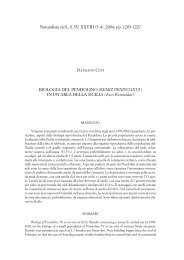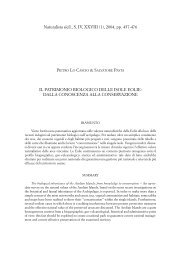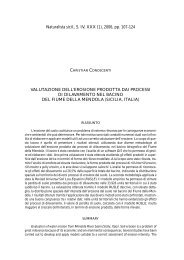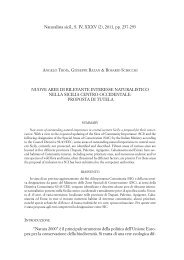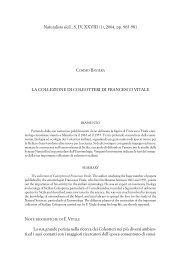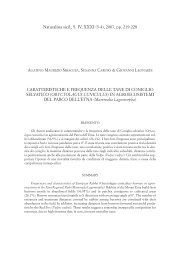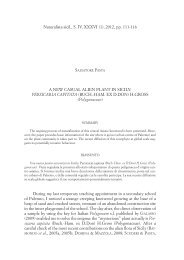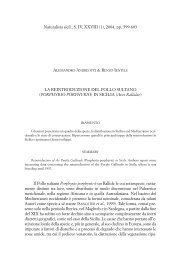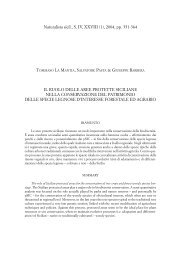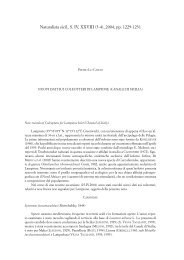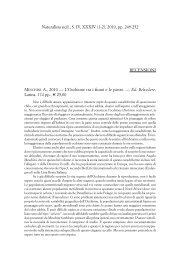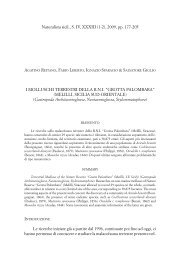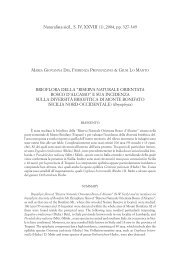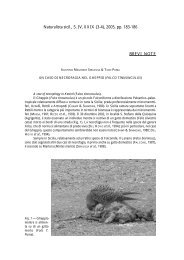2007,pp - Società Siciliana di Scienze Naturali
2007,pp - Società Siciliana di Scienze Naturali
2007,pp - Società Siciliana di Scienze Naturali
Create successful ePaper yourself
Turn your PDF publications into a flip-book with our unique Google optimized e-Paper software.
272 M. SKUHRAVÁ, V. SKUHRAVY´ & B. MASSA<br />
Asphondylia pruniperda Rondani, 1867<br />
Syn. Asphondylia prunorum Wachtl, 1880<br />
Larvae develop in buds of Prunus domestica and P. spinosa (Rosaceae)<br />
(Pl. VI, Fig. 38). Each gall contains a large cavity with a single larva. Only one<br />
generation develops per year. Adults emerge at the end of June and in early<br />
July. Females lay eggs in the young buds. Pupation takes place in the gall in<br />
the following year. Occurrence: DE STEFANI (1917) recorded this species in<br />
Sicily without giving a locality. DARVAS et al. (2000) consider this species as a<br />
minor pest of plum trees. Distribution: European.<br />
Asphondylia rosmarini Kieffer, 1896<br />
A single larva causes a small pouch gall on a leaf of Rosmarinus officinalis<br />
L. (Fabaceae). Occurrence: DE STEFANI (1904, 1906c) found galls of this<br />
species at “R. Villa Favorita”, Palermo from January to April, and obtained<br />
from them many species of parasitoids; moreover he recorded it from Latium<br />
(DE STEFANI, 1904). Distribution: Me<strong>di</strong>terranean.<br />
Asphondylia stefanii Kieffer, 1898<br />
A solitary larva develops in deformed siliquas of Diplotaxis tenuifolia (L.)<br />
DC (Brassicaceae) (Pl. IV, Fig. 17). KIEFFER (1898) described this species basing<br />
on material sent him by De Stefani from Palermo and named it to his honour.<br />
Galls of this species were <strong>di</strong>scovered by H. Ross at Marsala in 1898 (MAS-<br />
SALONGO & ROSS, 1898). Occurrence: DE STEFANI (1901, 1905b, 1906c) found<br />
it at Mazara del Vallo, Marsala and Santa Ninfa (Trapani), recor<strong>di</strong>ng it also on<br />
Sinapis nigra L. (Brassicaceae) in August-September, when D. tenuifolia was<br />
no more available for the insect. References: TROTTER & CECCONI (1900-1917:<br />
N. 63), Marsala, leg. De Stefani, 1899. Distribution: Me<strong>di</strong>terranean.<br />
Asphondylia trabuti Marchal, 1896<br />
Larvae live gregariously within the fruits of Solanum nigrum L.<br />
(Solanaceae). Several generations may develop a year. Occurrence: RIZZO &<br />
MASSA (1998) stu<strong>di</strong>ed the biology and listed some parasitoids attacking this<br />
species in Sicily, where it is widespread and common in summer. Distribution:<br />
Me<strong>di</strong>terranean.<br />
Asphondylia verbasci (Vallot, 1827)<br />
Larvae develop in swollen flower buds of Verbascum sinuatum L. (Scrophulariaceae)<br />
(Pl. V, Fig. 25). Several generations develop a year. Occurrence:<br />
Sicily, in summer (DE STEFANI, 1905a, who also records some parasitoids; DE<br />
STEFANI, 1906c, DE STEFANI jr, 1942). Distribution: Me<strong>di</strong>terranean and sub-



